 |
| My year in finished illustrations. Excuse the blurred images, NDAs sadly do not all expire when the ball drops |
David Palumbo
For many of us, the turning of the New Year is a time to step back and check our position on the map. To assess our place in Big Picture terms. To make those resolutions.
I tend to start doing that about a week or two later, because Spectrum entries aren’t due quite yet and I‘m just not that much of a go-getter to turn them in early.
Since the first year that I submitted to Spectrum, I found the deadline roughly coinciding with the New Year to be a terrific opportunity for placing all of my recent work into a sort of context for making new goals. Of course there are other annuals and they each serve as a similar opportunity, but this season in particular is when that subject really feels relevant. It may be because Spectrum represents such a benchmark to so many in the genre world. It may be because it is easy to group by year of creation so assessing the past year feels odd in, say, October.
Either way, New Years resolutions are being made and I’m also looking back on twelve months of work trying to select my best contenders. It only seems natural to pause and ask if that work is headed in a favorable direction.
Always looking for lazy ways to be better organized, I decided in 2012 to create a folder where I would save a low-res image of every painted work that I created that year as they were completed. The motivation for this actually was purely intended to make life easier at Spectrum submission time because I would have everything all in one place where I could scroll through. No more trying to remember when something was finished or worrying I might accidentally omit a piece. Beyond this though, it turned out to be a really helpful system for taking a brutally honest review of my year. Kind of like one of those Facebook year-end slide shows except, you know, useful and interesting.
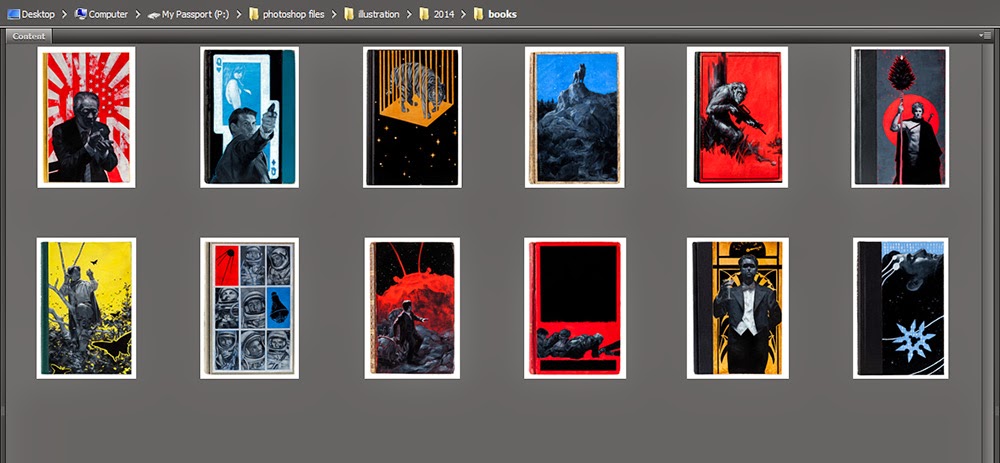 |
| Re-Covers completed this year. Already working on new ones for 2015 |
Each year’s folder contains every piece created. Period, the end. The one for that really frustrating art director that got boxed in to a weird outcome? In there too. That person piece that totally missed the mark? In there too. That little warm-up oil sketch that actually came out really good? In there too. Going back through them, it is easy to suddenly see them as a group indicative of how well I am spending my time and efforts. Themes, patterns, quality fluctuation, overall quantities… all right there in one big grid. And, most importantly, I can look at that collection and noticing what should have been there but isn’t.
Every year when I do this, it feels like a splash of cold water in my face. I have seen increased output correlate with far fewer stand-out “WOW” pieces. I’ve noticed long gaps where I was so focused on client work that I had abandoned personal experimentation. I’ve definitely tracked how many favorites were painted for a client and how many were just for me. This year, I intend to find some answers as to what step my personal work needs to take next, as I believe more strongly than ever that it is through personal work that the client work also evolves. I have an inkling that it will involve “do more of it” (note: in gathering the images for this post, I actually did spot a trend this past year in that I did a healthy amount of personal work, but almost none of them were full sized finished pieces, leaning much more in the realm of studies and experiments. Something to chew on.)
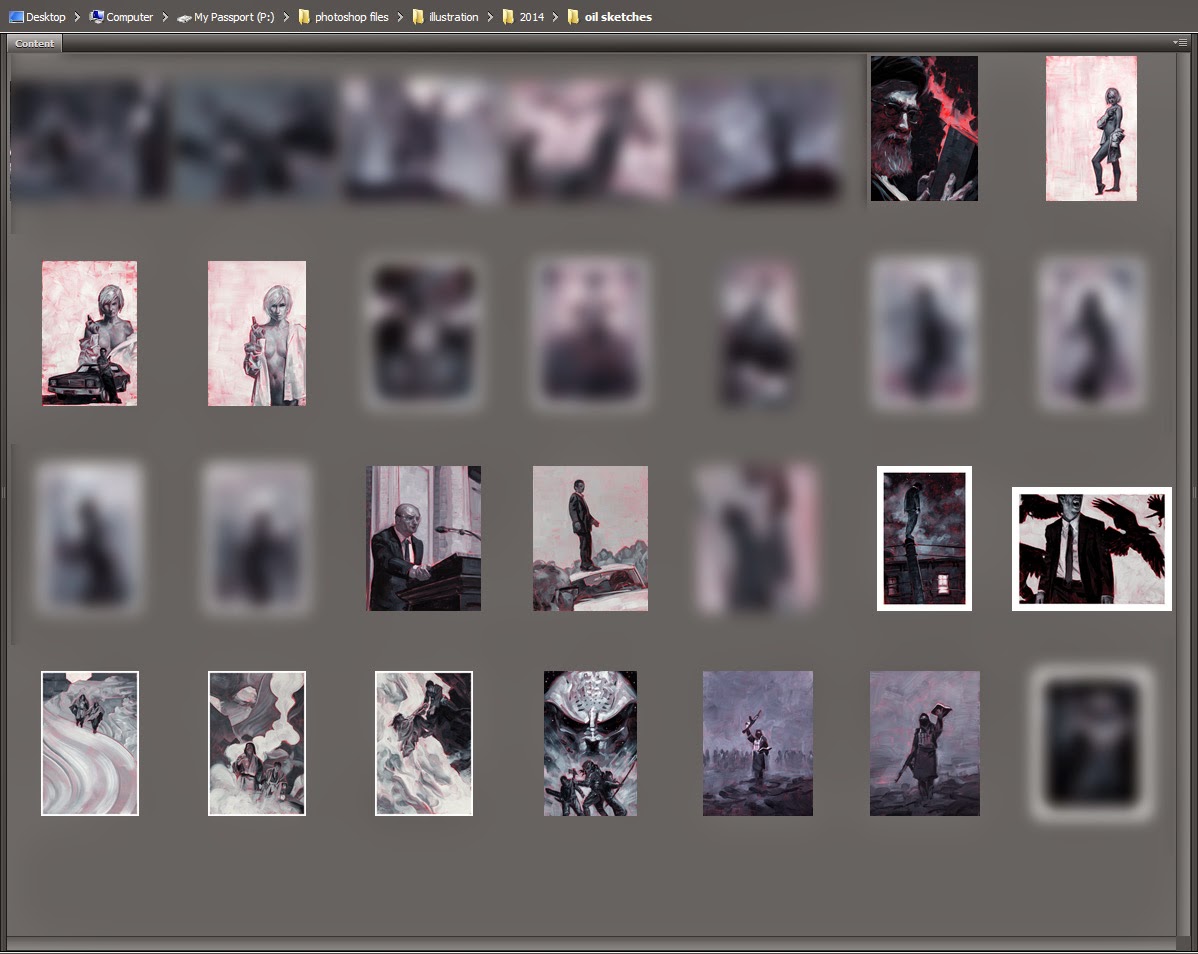 |
| A recent development, but my sketches now count as painted works since I started doing them in oils. The subject of a future post. |
The thing is I’m often wrong in my expectations, in part because I’ll forget which pieces happened or didn’t happen in the year. But that is the whole point. The chronological distance does not always match the emotional, intellectual, or conceptual distance from piece to piece and so it is a tremendous value to step back at regular periods such as this and assess the state of things.
The questions: “would I be engaged by this work if someone else had done it?” and “Am I excited to see what happens next?” are two of the most important questions for an artist to ask, but they are only meaningful to assessing growth when applied to a body of work and not just individual pieces. All the better if that body of work is an un-weeded sample, warts and all. The past year is your mirror. The past year is your road map.



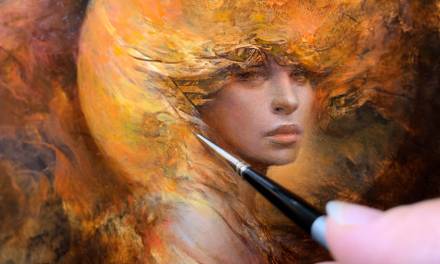
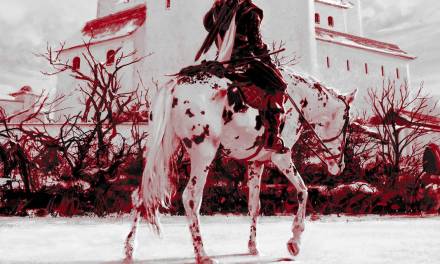
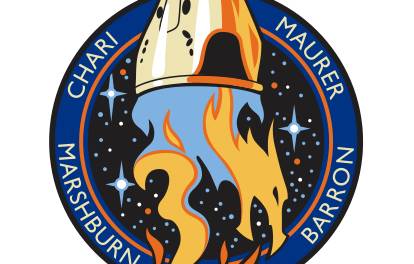
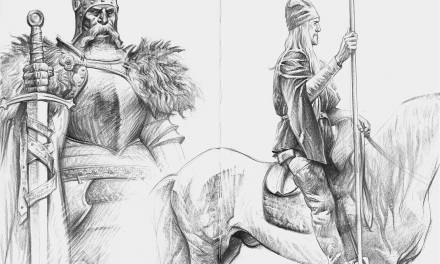
David, it's a tribute to the power of your designs that all of your pieces read perfectly well in their tiny thumbnail form, less than 100 pixels across.
High praise from Mr. James Gurney himself!
Great post Dave! I always love seeing your work. And I'd also like to complement you for being so prolific this year. Almost one finished piece for each week of the year, not to mention oil sketches, and those beautiful book covers! Well done dude!
P.S. sorry about the delete/repost the typos were bugging me.
Thanks Jim! Actually, that is another point on selecting for juried shows too. Of course it is far from the only factor, but since quick reading thumbnails stand a better chance of getting a distracted jurors attention it can't hurt to scan the group in miniature.
Thanks Keith, very much appreciated!
So many little thumbnails that I keep trying to click on to expand, and can't!
Great post, Dave, and a fantastic look back at your year as well. I for one am excited to see where it's going. 😉